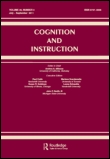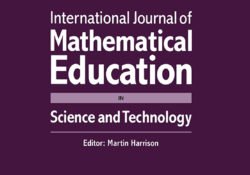
tandfonline.com har udgivet en rapport under søgningen “Teacher Education Mathematics”: Abstract Abstract Creating learning environments that integrate arts, sciences, and computing in education can improve learning in these disciplines. In particular, transdisciplinary integrations of these disciplines can lead to expansive alterations or dissolutions of epistemological, ideological, and methodological boundaries. We wish to support teachers in the creation of transdisciplinary learning environments that draw on art, science, and computing. We developed a classroom project genre, Luminous Science, that was designed to bridge disciplinary materialities, epistemologies, and representations through students’ construction of computationally-rich representations of physical phenomena. We present a study of a multidisciplinary group of teachers co-designing a Luminous Science unit for their classrooms using sculptural lanterns with programmable media for both investigations and expressions of classroom gardens. We present a… Continue Reading →
Like this:
Like Loading...
tandfonline.com har udgivet en rapport under søgningen “Teacher Education Mathematics”: ABSTRACT ABSTRACT In Finland, curriculum design is allegedly carried out through a deliberative process that involves various stakeholders, interest groups, experts and ordinary citizens. To facilitate participation in curriculum design, online crowdsourcing has been applied. The objective of this study is to explore to what extent the design process of the latest Finnish national curriculum for mathematics was open, democratic and deliberative. The theoretical framework of the study is the theory of democratic will-formation of the German philosopher Jürgen Habermas. The comments given on the early version of the core curriculum of mathematics were analysed using directed content analysis, in which the above theory was applied. In the empirical analysis, the comments on the core curriculum were divided into three… Continue Reading →
Like this:
Like Loading...
eric.ed.gov har udgivet: The authors’ hypothesis is that if teachers (as experts) understand and teach concepts from the position of expertise teacher quality will improve. They believe that focusing on the key ideas will deepen both teacher and student understanding and allow learners to build the concepts necessary to form solid foundations for the application of mathematics both in and out of school. But such methods of instruction often require that teachers learn to reorganize and teach fundamental concepts in more expert-like ways. Because many teachers were taught in a system that stressed procedure rather than conceptual understanding, and the dearth of guidance on how teachers might change their teaching in this manner, such change may be difficult. Building on the expert-novice literature, and the findings by Carpenter, Fenamya, Levi,… Continue Reading →
Like this:
Like Loading...
tandfonline.com har udgivet en rapport under søgningen “Teacher Education Mathematics”: ABSTRACT ABSTRACT Background: Research on peer assessment has noted ambiguity among students in using peer assessment for improving their work. Previous research has explained this in terms of deficits in the student feedback, or differences in student views of what counts as high-quality work. Purpose: This study frames peer assessment as a social process in the science classroom. The aim is to explore peer assessment in science education as social practice in order to contribute to an understanding of the affordances and constraints of using peer assessment as a learning tool in science education. Design and Method: The study was conducted in four lower secondary school classes, school years 8 and 9, in two different schools. An intervention study was… Continue Reading →
Like this:
Like Loading...
eric.ed.gov har udgivet: This study was designed to initiate the process of building professional development learning communities for pre-service math teachers through revealing those teachers’ conceptions/beliefs of students’ learning and their own learning in China. It examines Chinese pre-service math teachers’ conceptions of student learning and their related pedagogical beliefs with respect to the following four aspects: self-regulation, construction of knowledge, the social nature of learning, and a dynamic view of ability. A total of 129 middle-school and secondary pre-service math teachers from China participated in this study. The results indicated that the Chinese pre-service teachers’ conceptions of student learning and their pedagogical beliefs are constructive, process-oriented, and progressive. In addition, the traditional Chinese socio-cultural values still have an impact on the pre-service teachers’ conceptions of student learning. Implications and… Continue Reading →
Like this:
Like Loading...
tandfonline.com har udgivet en rapport under søgningen “Teacher Education Mathematics”: An Integral Design Framework —designing a global village Link til kilde
Like this:
Like Loading...
eric.ed.gov har udgivet: In recent years, tablets have been shown to serve as incredible teaching tools in classrooms around the world. In mathematics education, divergent thinking, creativity, and play may play a key role in formation of adaptive thinking and math achievement. This qualitative, participatory action research investigated the use of an instructional model that provided minimal instruction in the use of tablets to create stop motion animation movies. This study focused on the themes and patterns that emerged as pre-service teachers integrate a design thinking philosophy as they explore creativity and divergent thinking through the creation of stop motion animation movies. This study employed a participatory action research design that examined the use of an instructional approach informed by design thinking that utilized tablets to enable preservice teachers to… Continue Reading →
Like this:
Like Loading...
tandfonline.com har udgivet en rapport under søgningen “Teacher Education Mathematics”: ABSTRACT ABSTRACT Spatial reasoning plays a vital role in choice of and success in science, technology, engineering, and mathematics (STEM) careers, yet the topic is scarce in grade school curricula. We conjecture that this absence may be due to limited knowledge of how spatial reasoning is discussed and engaged across STEM professions. This study aimed to address that gap by asking 19 professionals to comment on a video that documented children’s progression through 5 days of building and programming robots. Their written opinions on the skills relevant to their careers demonstrated by the children revealed that spatial thinking and design thinking are central to what they see. RÉSUMÉ Le raisonnement spatial joue un rôle essentiel dans la décision d’entreprendre une carrière… Continue Reading →
Like this:
Like Loading...
eric.ed.gov har udgivet: This paper reports design and implementation outcomes at middle development advance of an educative program based on use and construction of widgets on Wolfram Alpha platform at higher education level for engineering and sciences areas. Widgets were based on Physics and Mathematics curricula under Project Oriented Learning and Blended Learning methodologies. Widgets constructed by teachers are first used by students to appropriate basic concepts of each course on a mobile learning basis; after, students construct their own widgets applying that concepts but involving different applied situations based on curriculum integration. Two phases of this activity help to develop basic and high level thinking. Description of design combining Wolfram Alpha widget developer, Weebly and Jotform tools to set up the widgets, institutional current advances on teachers training, courses… Continue Reading →
Like this:
Like Loading...
tandfonline.com har udgivet en rapport under søgningen “Teacher Education Mathematics”: ABSTRACT Formulae display:?Mathematical formulae have been encoded as MathML and are displayed in this HTML version using MathJax in order to improve their display. Uncheck the box to turn MathJax off. This feature requires Javascript. Click on a formula to zoom. ABSTRACT This paper uses a post-qualitative philosophical perspective to find new ways of understanding teaching and learning. The paper presents a series of examples that were used in a longitudinal study, with the aim of creating variation patterns that would make it possible for students to discern the use of the four basic arithmetic operations in different situations. The focus of this article is the potential of the examples to systematically create variation patterns that students need to perceive… Continue Reading →
Like this:
Like Loading...





